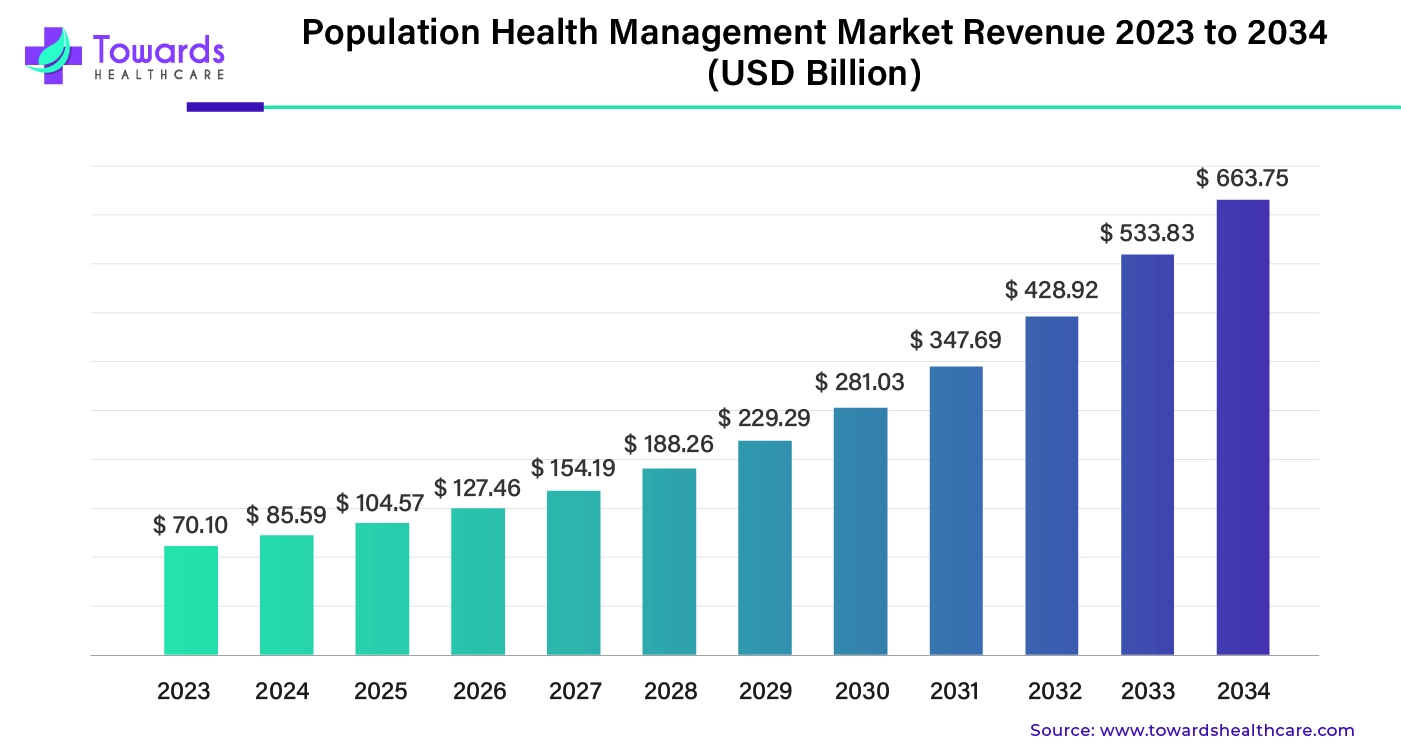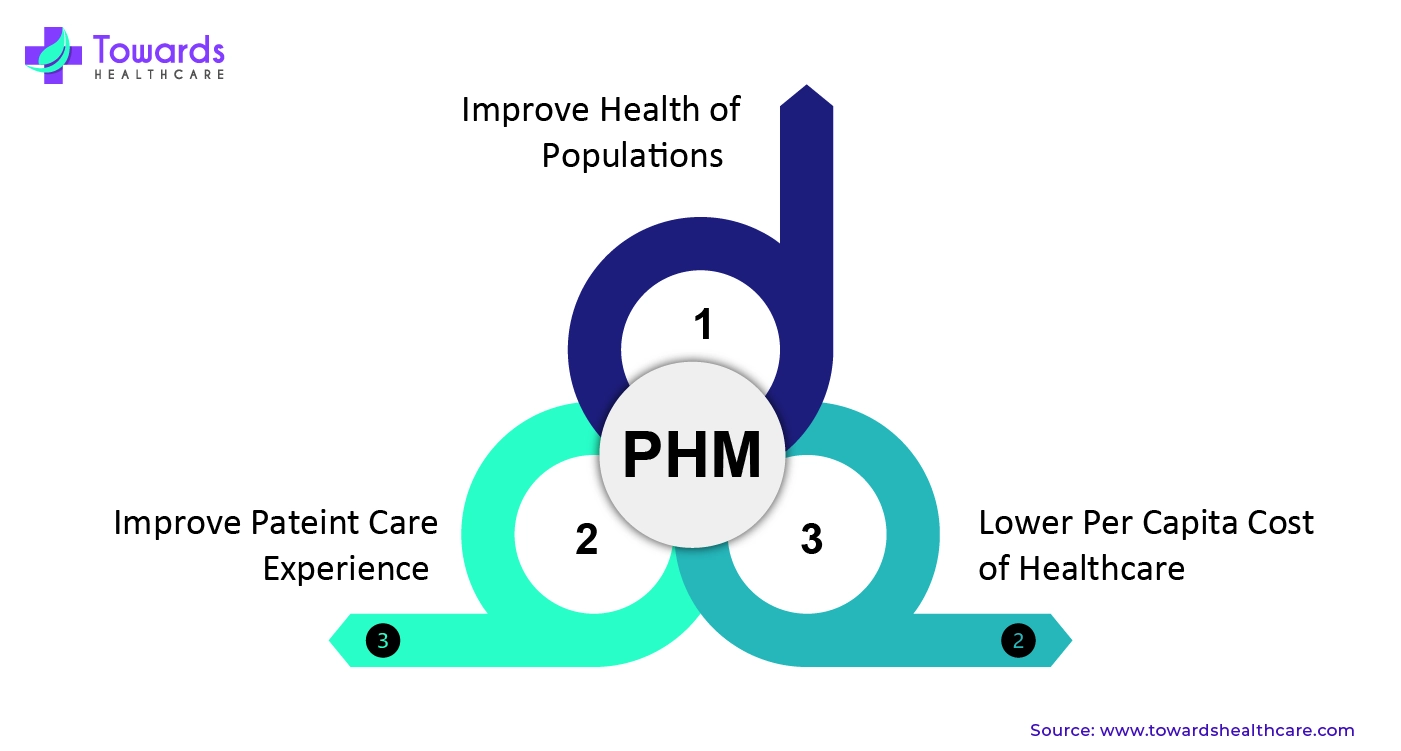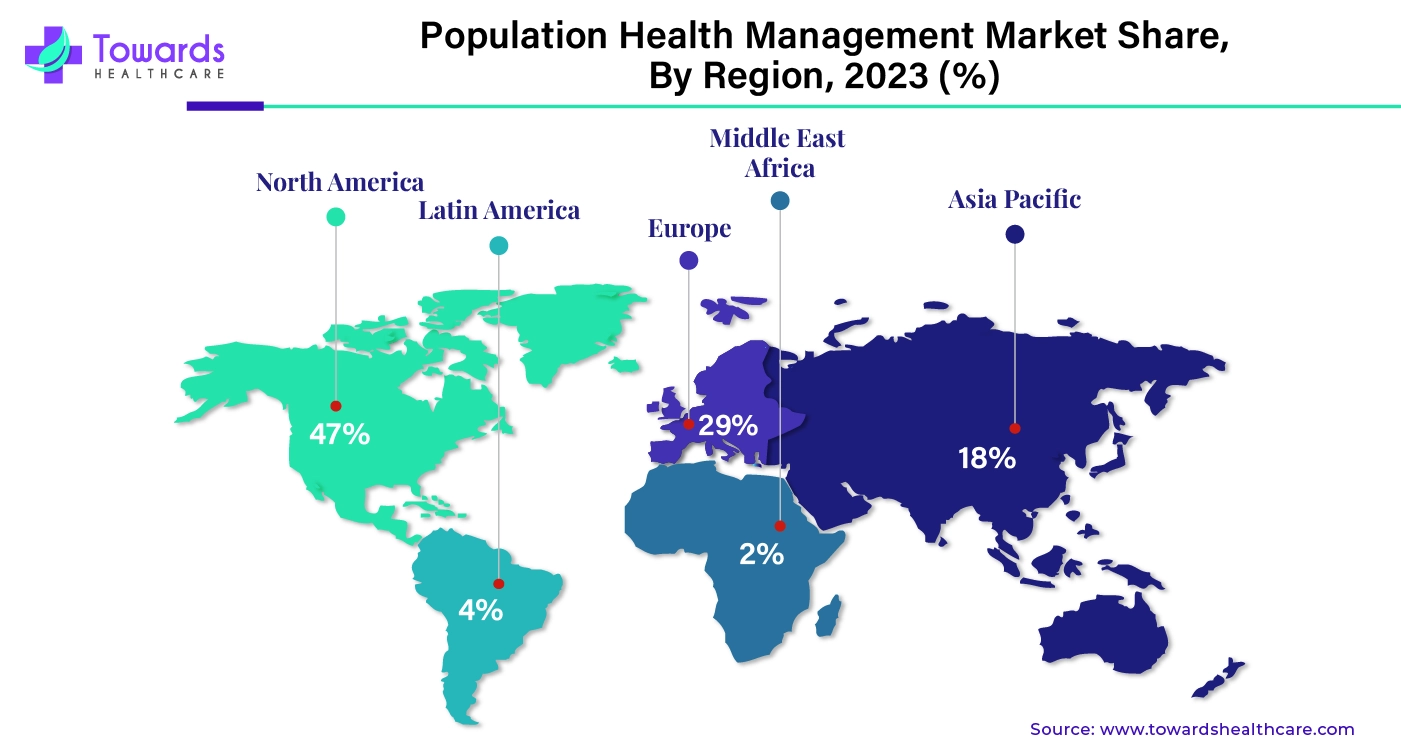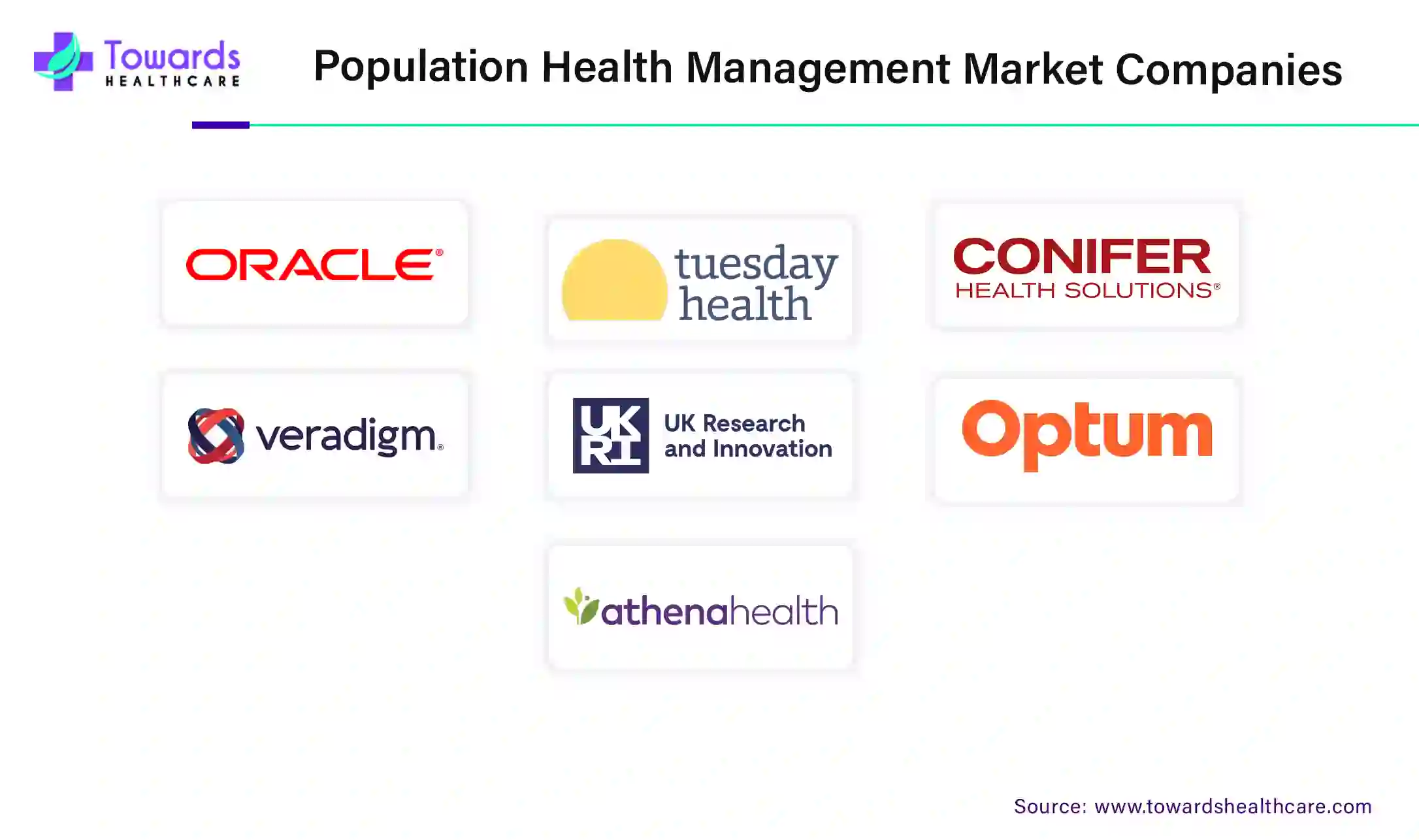April 2025

The global population health management market was estimated at US$ 70.10 billion in 2023 and is projected to grow to US$ 663.75 billion by 2034, rising at a compound annual growth rate (CAGR) of 22.05% from 2024 to 2034.

The purpose of this market is to provide resources (financial and care models) for improving clinical health outcomes of defined groups by using better care coordination and better patient engagement. Population health management (PHM) includes care coordination, return on investment (ROI), healthcare quality, resource management, healthcare reform, outcomes assessment, health economics, provider incentives, compliance programs, and clinical case reports and studies on the management of public health conditions. PHM uses healthcare data to make evidence-based decisions to create better health systems. Technology is used for data aggregation, data analytics, and data governance.

Artificial intelligence plays a crucial role in PHM by providing support in predictive analytics, data management, data analysis, task allotment, and so on. AI can be useful in improving patient care and reducing costs. With the help of predictive analysis, AI can help analyze at-risk and emerging risks, which will help with using minimal resources. Other PHM processes in which AI can be used include the estimation of potential effects of policy change, better identification of subgroups who need healthcare, scientific literature translation, assisting in systematic reviews, emergency prediction, preparedness, and response.
For instance,
The entire purpose of PHM is to ensure better health outcomes while using minimal resources. There is always a growing demand for better patient health outcomes, which drives the population health management market. PHM addresses patient values, needs, and preferences. PHM also promotes patient-centered care by providing favorable interventions and reducing hospital readmission rates. PHM provides real-time data to healthcare providers, which helps the professional to make evidence-based decisions that improve the overall quality of patient care, patient satisfaction, and quality of life.
For instance,
A large amount of medical, patient-related, financial, and other clinical data is generated in PHM. The data is majorly stored on cloud storage systems, which puts it at a high risk of getting stolen, deleted, or misused, which restrains the growth of the population health management market. Cyber attacks can hamper the overall research, develop ethical issues, cause financial losses, and ultimately hamper the reputation of a company or an organization. It becomes highly essential for organizations, hospitals, and third-party service providers to develop strong security systems to avoid any invasion into systems.
Value-based medicine is a more contemporary method of providing healthcare that integrates patient-centered care, evidence-based medicine, and cost-effectiveness to concentrate on the aspects of therapy that patients find useful. Population health is now at the forefront of health policy formation as a result of the shift in emphasis from a fee-for-service to a value-based paradigm. A growing number of payers are supporting risk-sharing payment models, and creative, non-traditional payer-provider partnerships are emerging. As a result, the emphasis has shifted from individual healthcare payments at the point of care to comprehensive healthcare management for a specific or defined population or population health management.
For instance,
By product, the services segment held the largest share of the population health management market in 2023. There are various services associated with population health management. Many healthcare providers hire third-party organizations for PHM services, which gives healthcare providers better solutions and better cost management. With the growing prevalence of chronic conditions and advancement in healthcare services, the demand for PHM services is growing.
For instance,
By delivery mode, the cloud-based segment dominated the population health management market in 2023 and is estimated to grow at the fastest rate during the forecast period. Cloud-based delivery mode has become the need for transferring, storing, and managing the large amount of data generated in PHM. It can become tedious and time-consuming if data is stored on local servers. Cloud-based systems make it easy to access data from anywhere and by anyone. With growing telehealth and telemedicine, and providing healthcare services in remote areas, cloud-based systems become really essential for healthcare providers and third-party organizations that provide PHM.
For instance,
By end-use, the healthcare providers segment held the dominant share of the population health management market in 2023. Healthcare providers use PHM the most because the main purpose of PHM is to improve the quality of care and develop new processes to enhance the patient experience while ensuring that the overall cost is within budget. Healthcare providers use PHM data to analyze diseases, patient needs, patient response, economics, and other aspects. The analysis is then used to develop better solutions. With growing research and development, technological advancements, chronic conditions, rare diseases, population, and environmental changes, the PHM will continue to grow, and the demand for it from healthcare providers will also grow in the future.
By region, North America dominated the population health management market share by 47% in 2023. Technological advances play a crucial role in population health management, and North America leads the market in terms of technological advancements. There are multiple organizations and government authorities that promote and invest in the growth and development of technology. Apart from this, the region is known for its well-developed healthcare infrastructure, research and development in healthcare, advanced systems, and well-trained professionals that further help in the growth of the market. The major countries that contribute to the growth of the market in North America are the U.S. and Canada.
The U.S. held the dominant share of the population health management market in North America. The country has organizations such as the FDA, AHA, OASH, and WHO that help in the growth and development of PHM. For instance, the OASH launched the Health People 2030 initiatives to improve the health Application, software, machine learning, AI, and many more technologies used in PHM, which are readily available in North America due to various third-party service providers. and well-being of people over the next decade. Apart from this, there are various key population health management market players that provide PHM services in the U.S.
For instance,
Case Study of U.S. Based Company: USI
Of all the main brokerages in the U.S., USI has one of the largest and most extensive networks of Population Health Managers (PHM). With over 10,000 colleagues spread throughout more than 200 offices countrywide, USI now generates more than $2.7 billion in sales. The organization saw a 62% increase in preventative visits after putting USI's suggested CORE HEALTH plan into practice. Preventative visits are essential for spotting possible high-cost claims. Additionally, a 40% decrease in ER visits was attributed to an increase in primary care visits. Compliance with diabetes treatment improved, saving the self-funded plan around $145K in chronic illness management. As a consequence, the business's average renewal hikes decreased from over 10% in the previous two years to less than 5% in the most recent three, saving the company almost $1.1 million.

By region, Asia Pacific is expected to grow at the fastest rate during the forecast period. With growing research and development, the healthcare infrastructure in Asia Pacific is growing, which is increasing the demand for the population health management market. The development of healthcare infrastructure in the region is due to the growing prevalence of diseases, the growing population, and the growing healthcare initiatives in developing & underdeveloped countries. Countries like China, India, Japan, and South Korea are the major contributors to the market’s growth.
The Indian government is taking major steps to improve India's healthcare infrastructure. For instance, the Ministry of Health and Family Welfare launched SAKSHAM, which is a health-related training program for developing a better healthcare workforce. There are 26,508 SAKSHAM users, 303 medical courses, 278 public health courses, 244 instructors, 5,02,298 TIMS users, and 1,024 total physical training through TIMS.
Japan also contributes to the growth of the population health management market. Japan has long been an active partner of WHO and a fervent advocate for world health, working to ensure that everyone has access to healthcare and that no one is left behind. Japan contributes to the strengthening of other nations' health systems, the battle against drug-resistant bacteria that jeopardize drug efficacy, and the promotion of healthy aging, diet, and other factors. The Global Outbreak Alert and Response Network (GOARN), a WHO network of over 250 technical partners, is supported by Japanese institutions and organizations. Its purpose is to provide manpower and resources to acute public health emergencies.
Justin Neece, CEO of i2i Population Health, commented on collaboration with CureMD that the company aims to make population health management more accessible, scalable, and effective for healthcare organizations. He also added that the company will utilize CureMD’s EHR platform with its tools to enable providers to take proactive action on patient care, leading to better outcomes and higher efficiency.

| Company Name | Tuesday Health |
| Headquarters | Tennessee, U.S., North America |
| Recent Development | In May 2024, Tuesday Health is a value-based care business that focuses on serious diseases. It has introduced a solution that emphasizes acquiring the correct services from the finest providers at the right moment in an individual's life and providing supportive care early in a patient's journey. The launch is supported by a $60 million strategic investment from Valtruis, Mass General Brigham Ventures, Blue Venture Fund, and CareSource, the biggest Medicaid plan in Ohio. |
| Company Name | UKRI |
| Headquarters | Wiltshire, England, Europe |
| Recent Development | In March 2024, Population Health Improvement UK (PHI-UK) is an initiative of UK Research and Innovation (UKRI) that brings together knowledge and perspectives from community groups, public health, and research with a £35 million investment spread over four years. |
By Product
By Delivery Mode
By End-use
By Region
April 2025
April 2025
April 2025
April 2025